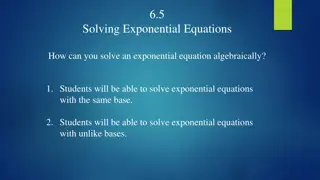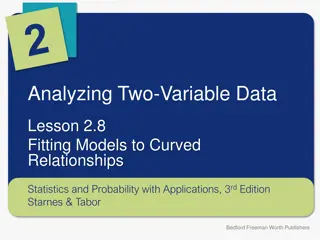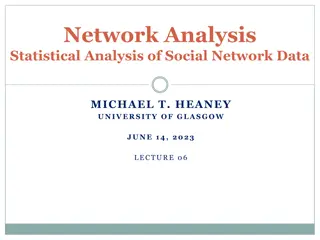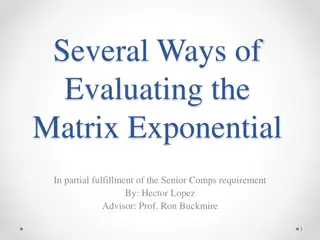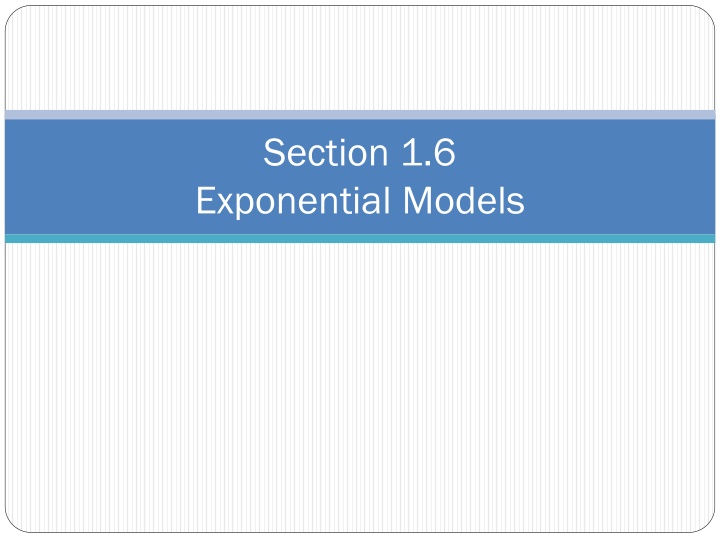
Exponential Models for Predicting Growth
Explore the concept of exponential models in mathematics for predicting growth in various aspects of society such as population, money, and pollution. Learn how to simplify exponential functions and graph exponential equations. A practical example demonstrates how exponential models can be used to predict the future population growth of the United States.
Download Presentation

Please find below an Image/Link to download the presentation.
The content on the website is provided AS IS for your information and personal use only. It may not be sold, licensed, or shared on other websites without obtaining consent from the author. If you encounter any issues during the download, it is possible that the publisher has removed the file from their server.
You are allowed to download the files provided on this website for personal or commercial use, subject to the condition that they are used lawfully. All files are the property of their respective owners.
The content on the website is provided AS IS for your information and personal use only. It may not be sold, licensed, or shared on other websites without obtaining consent from the author.
E N D
Presentation Transcript
Section 1.6 Exponential Models
The Euler number The Euler number . 2 718 ..... e
Example 1 Simplify the following exponential functions 2 ) A e 3 ) B e 1 ) C e 3
Solution to Example 1 Use a scientific calculator we get the following values. = 2 ) . 7 39 A e 1 e = = 3 ) . 05 B e 3 1 . 1 = ) 40 C e 3
Example 2 Graph ? = ??
Solution to Example 2 Graph ? = ?? ? = ?? ? ? = ? 2= .1 2 ? = ? 1= .4 1 ? = ?0= 1 0 ? = ?1= 2.7 1 ? = ?2= 7.4 2
Solution to Example 2 Graph of ? = ??
Example 3 Graph ? = ??+ 2
Solution to Example 3 Graph ? = ??+ 2 ? = ??+ ? ? ? = ? 2+ 2 = .1 + 2.0 = 2.1 2 ? = ? 1+ 2 = .4 + 2 = 2.4 1 ? = ?0+ 1 = 1 + 2 = 3 0 ? = ?1+ 1 = 2.7 + 2 = 4.7 1 ? = ?2+ 2 = 7.4 + 2 = 9.4 2
Solution to Example 3 Graph 10 8 6 y = ex+2 4 2 -5 5
Exponential Models Exponential models are used to predict human populations, animal populations, money growth, pollution growth, and other aspects of society that fit exponential models. The variable of an exponential model is found in the exponent of the equation.
Exponential Growth ? = ?0??? ? = ??? ????? ??= ??????? ????? ? = ???? ? = ????
Example 3 The population of the United States is 320 million, what would be the population of the U. S. be in 20 years if its population would growth at a steady rate of .7 % for 20 years?
Solution to Example 3 ??= 320 ??????? ? = .007 ? = 20 ????? ? = ?0???= 320?(.007)(20)= 320?.14 368 ???????
Example 4 The population of Blacksburg, Virginia is 41,000, what would be the population in 10 years if Blacksburg would grow at a rate of 1.1 % per year?
Solution to Example 4 ??= 41,000 ? = .011 ? = 10 ????? ? = ?0???= 41,000?(.011)(10)= 41,000?.11 45,767
Example 5 Past Study: In 1995 the United States had greenhouse emissions of about 1400 million tons, where as China had greenhouse emissions of about 850 million tons. If in the next 25 years China greenhouse emission grew by 4 percent and the U. S. greenhouse emission grew by 1.3 percent, what would the emissions in tons for both countries in 2020?
Solution to Example 5 US Emissions: = kt P P 1400 e 0 = P million 013 . = 0 3 . 1 = % r = 25 t = = = 013 . ( 25 )) . 325 1400 1400 1938 P e e million tons
Solution to Example 5 China s Emissions = kt P P 850 e 0 = P million 04 . = 0 = 0 . 4 % r = 25 t = = = 04 . ( 25 ) 1 850 850 2311 P e e million tons
Exponential Decay Exponential decay models are use to measure radioactive decay, decreasing populations, Half-life, and other elements that fit an exponential model. Again, the one variable in an exponential decay models in found in the exponent
Exponential Decay ? = ?0? ?? ? = ??? ????? ??= ??????? ????? ? = ???? ? = ????
Example 6 A certain population of black bears in the eastern United States has been decreasing by 3.1 percent per year. If this trend keeps up, what will be the population of bears in 20 years if there are currently 1000 bears.
Solution to Example 6 Use the decay model = 1000 P 0 = = 1 . 3 % 031 . k = 20 = t kt P P e 0 = . 031 ( 20 ) 1000 P e = . 62 1000 P e (. = = 1000 538 ) 538 P bears
Example 7 A certain isotope decreases at a rate of 5% per year. If there is currently 340 grams of the isotope, how many grams of the isotope will there be in 20 years?
Solution to Example 7 Use the decay model = kt P P 340 e 0 = P 0 = = 5 % . 05 k = 20 t = = = = . 05 ( 20 ) 1 340 340 340 3678 (. ) 125 P e e grams
Example 8 A certain isotope decreases at a rate of 6% per year. It there is currently 250 grams of the isotope, how many grams of the isotope will there be in 25 years?
Solution to Example 8 Use the decay model = kt P P 250 e 0 = P 0 = = 6 % . 05 k = 25 t 5 . 1 = = = . 06 ( 25 ) 340 10000 56 P e e grams


